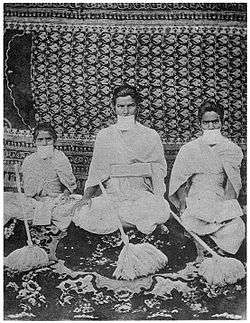Sthānakavāsī
| Part of a series on |
| Jainism |
|---|
 |
|
Jain prayers |
|
Ethics |
|
Major sects |
|
Festivals |
|
|


Sthānakavāsī is a sect of Śvētāmbara Jainism founded by a merchant named Lavaji in 1653 AD. It believes that idol worship is not essential in the path of soul purification and attainment of Nirvana/Moksha. The sect is essentially a reformation of the one founded on teachings of Lonka, a fifteenth-century Jain reformer. Sthānakavāsins accept thirty-two of the Jain Agamas, the Śvētāmbara canon. Śvētāmbarins who are not Sthānakavāsins are mostly part of the Murtipujaka sect.
Saints

Saints (ascetic Sthanakvasins, called maharaj saheb's) wear white clothes and cover their mouths with a square white cloth or muhapatti intended to minimize the risk of inhaling small insects or other airborne life forms, which Sthanakvasins see as a violation of ahimsa "non-violence". They eat food collected from followers' houses and do not save edibles beyond the next meal and water is not kept even for a single night. All eating and drinking has to be done between sunrise and sunset.
Saints do not stay at one place for too long except for the four monsoon months, the chaturmas. Saints are also called dhundhiya "searchers" for their early practice of searching out and staying in abandoned or neglected structures to avoid disturbance from the public. Saints own no possessions except for a few books, a couple sets of clothes and carrying utensils made of a special natural material.
Sthanakwasi : The Sthanakwasi arose not directly from the Shwetambars but as reformers of an older reforming sect, viz., the Lonka sect of Jainism. This Lonka sect was founded in about 1474 A.D. by Lonkashah, a rich and well-read merchant of Ahmedabad.
The main principle of this sect was not to practice idol-worship. Later on, some of the members of the Lonka sect disapproved of the ways of life of their current ascetics, declaring that they lived less strictly than Mahavira would have wished. A Lonka sect layman, Viraji of Surat, received initiation as a Yati, i.e., an ascetic, and won great admiration on account of the strictness of his life. Many people of the Lonka sect joined this reformer and they took the name of Sthanakwasi, thereby intending to strictly follow on the principles of Lord Mahavir. Sthanakvasi means those who do not have their religious activities in temples but carry on their religious duties in places known as Sthanakas which are like prayer-halls.
The Sthanakwasis are also called by terms as
(a) Dhundhiya(searchers); or
(b)Sadhumargi(followers of Sadhus, i.e., ascetics).
Except on the crucial point of idol-worship, Sthanakwasi do not differ much from other Shwetambar Jains and hence now-a-days they invariably call themselves as Shwetambar Sthanakwasi. However, there are some differences between the Sthanakwasi and the Murtipujak Shwetambars in the observance of some religious practices. The Sthanakwasi do not believe in idol-worship at all. As such they do not have temples but only sthanakas, that is, prayer halls, where they carry on their religious fasts, festivals, practices, prayers, discourses, etc.
Further, the ascetics of Sthanakwasi cover their mouths with strips of cloth for all the time and they do not use the cloth of yellow or any other colour(of course, except white). Moreover, the Sthanakwasi admit the authenticity of only 32 of the scriptures of Shwetambars. Furthermore, the Sthanakwasis do not participate in the religious festivals (that related to temples and idol worship) of Murtipujak Shwetambars.
Subsects
There are Various organized sub-sects in Shwetambar Sthankawasi order
- Gyan Gaccha led by param pujya shrutdhar (active listner) pandit ratna 1008 shri Prakash Muni Ji M.S.
- Shraman sangh / Baaees sampraday led by Acharya Dr. Shiv Muniji Maharaj Saheb
- Gyan Gachchha Sampraday led by P.P.Gachchhadhipati Prakashchand ji M.S.
- Sadhu Margi Sampraday led by P.P. Acharya Shri Ramlalji Maharaj Saheb
Shant kranti Sampraday led by P.P 1008 Achraya Shri Vijayrajji Marasa
- Ratna Vansh Sampraday led by P.P. Acharya Shri hirachand ji M.S.
- Shri Arihant Margi Jain Sangh led by Acharya Shri Gyanchandraji M.S.
- Samrath Gachchha Sampraday led by P.P.Gachchhadhipati Uttamchandji M.S.
- Ajaramar Sampraday
- Gondal Sampraday led by Gachchhadipati Vaani Bhushan Param Pujya Shri Girish Muni Maharaj Saheb and Rashtra Sant Param pujya Namramuni Maharaj Saheb.
- Dariyapuri Sampraday
- Botad Sampraday
- Khambhat Sampraday
- Kutch 8 Koti Sampraday
- Kutch 6 Koti Sampraday
- Barvala Sampraday
- Limbdi Gopal Sampraday
and few more. The Shwetambar Sthanakwasi are also spread in different business centers in India but they are found mainly in Rajasthan, Gujarat, Maharashtra Punjab, Harayana, Karnataka and Tamil Nadu.
The two non-idolatrous sub-sects, viz., Taranapanthis among the Digambars and Sthanakwasi among the Shwetambars, came very late in the history of the Jain.
About 1474 A.D. the Lonka sect, the first of the non-idolatrous Jain sects, arose and was followed by the Dhundhiya or Sthanakwasi sect about 1653 A.D. dates which coincide strikingly with the Lutheran and Puritan movements in Europe.
The Shraman sangh of Sthanakvasi sect was formed in 1952 to unite all the ascetics under one Acharya. This is the largest Sthanakvasi group. Acharya Shiv Muni who is the leader of shraman sangh has regularly travelled all over India to impart the values of Jainism.